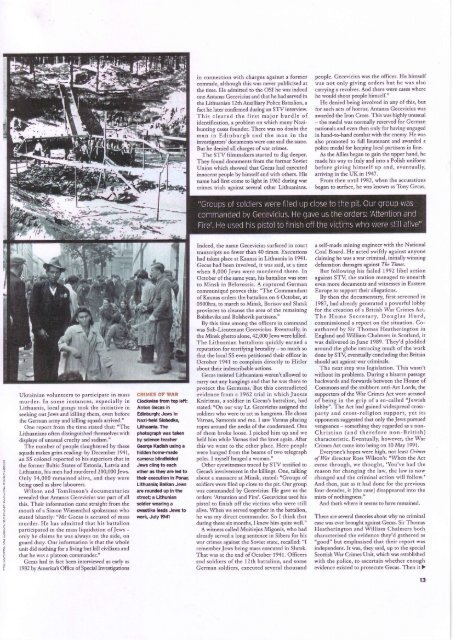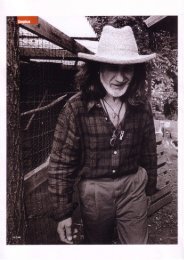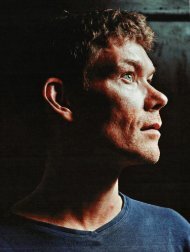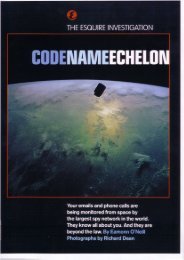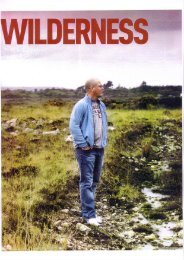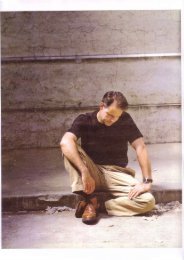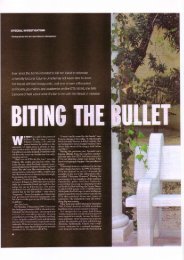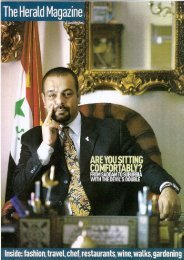Gecas - Eamonn O'Neill
Gecas - Eamonn O'Neill
Gecas - Eamonn O'Neill
Create successful ePaper yourself
Turn your PDF publications into a flip-book with our unique Google optimized e-Paper software.
in contrection with charges againsc a former<br />
comrade, although this was never publicis€d at<br />
the tine. He admitted to rhe OSI he was indeed<br />
one Antanas Gecevicius and dnt he had sewed in<br />
the Lithuanian 12th Au{illiary Police Battalion, a<br />
fact he later confirmed during an STV intervi€w.<br />
This cleared the firsc major hurdle ol<br />
identification, a problen on which manyNazihunting<br />
cases founder. There was no doubt th€<br />
man in Edinburgh and the men in th€<br />
investigltort documents w€re one and the same.<br />
But he denied a[ charges ofwar crimes.<br />
The STV filmmakers started to dig deeper.<br />
They found docunents fiom the forner Soviet<br />
Union which showed thar G€cas had execut€d<br />
innocent p€ople byhims€lfand wirh others. His<br />
name had first com€ to lightjn 1962 during*ar<br />
crimes trials ag"inst sever.l other Lithuanians.<br />
people. Gecevicius was the officer. He himselt<br />
rves not only giling orders but he was also<br />
carrying a revolver And there were cases where<br />
he would shoot people himself."<br />
He denied being involved in any of this, but<br />
for such acts ofhorror, Anianas G€cevicius was<br />
awrded dre Iron Cros. This was highly unusual<br />
- the nedal was normally reserved for Gernan<br />
nationals and ev€n then only ror having eng:ged<br />
in hand-to-hand combat vith the enemy. He was<br />
also promoted to tull lieutenent and awarded a<br />
police rnedal for keeping local partjsans in line.<br />
tu the Allies began to gain the upper hand, he<br />
made his way to ltaly and into a Polish uniform<br />
before giving himself up and, ev€ntually,<br />
arriving in the UK in 1947.<br />
Frorn then until 1982, when the accusations<br />
began to surhce, he was known as Tony <strong>Gecas</strong>,<br />
Uk.aini.n volunteers to participate in mass<br />
murder. In some instances, especielly in<br />
Lithuania, local gangs took the initiative in<br />
seeking outlews and killing them, even before<br />
the German armyand killingsquads arrived."<br />
One report Foln th€ time stared thrt "The<br />
Lithusnians oft€n distinFished thernselves with<br />
displays of uusual cruelty and sadism."<br />
The number ofpeople slaughtered by these<br />
squads nakes gaim reading: by December 1941,<br />
.n SS colon€l reported to his superiors that in<br />
the former Baltic States ofEstonia, Latvia and<br />
Lithuania, his men had murdered 200,000Jews.<br />
Only 34,000 temained alive, and th€y were<br />
being used as slave labourers.<br />
Wilson and Tomlinson's docum€ntaries<br />
revealed that Artanas Gecevicius was part ofall<br />
rhis. Their information came straighi ftom the<br />
mouth of, Simon Wi€senchal spokesman who<br />
stated bluntly, "Mr Indeed, the name Gecevicius surfaced in court<br />
transcripts no fewer tlan 40 times. Executions<br />
had talen place at Kaunas in Lidruania in l94l .<br />
<strong>Gecas</strong> had been involved, it eas seid, at a tim€<br />
when 8,000 Jews were murdered there. In<br />
October of the same year, his battalion was sent<br />
to Mirsk in Belorussia. A captured German<br />
communiqu6 proves this:<br />
CRIMES OF WAR<br />
clockwlse horn top l.tt:<br />
Edlnhurgh Jews In<br />
Nazl-held Slobodka,<br />
Llthuanla. The<br />
photogEph w.s taten<br />
ceorge r,Edlsh uslnq .<br />
other.s they are led to<br />
theh executlon In Ponan<br />
Llthu.nla; B.lk n Je$s<br />
are round.d up In the<br />
streee a Uthunlan<br />
<strong>Gecas</strong> k accused ofmass<br />
murder. H€ has.dm'tted that his battalion<br />
srEstlka leads Jews to<br />
parricipated itr the mxss liquidation ofJevs<br />
only he claims he was always on the side, on<br />
guard duty. Our information is that th€ rvhol€<br />
unitdid nothing for e living but killciviUans and<br />
thrr he was a platoon commander."<br />
<strong>Gecas</strong> had in facc been intewjewed as e.rly as<br />
1982 by America's Of6ce of Special Inv€stigrtions<br />
"The Commandant<br />
ofKaunas orders the battalion on 6 October, at<br />
0500hrs, to march toMinsk, Borisov and Slutsk<br />
provinces to cleanse the area ofthe remaining<br />
Bolshevik and Bolshevik partisans."<br />
By this time among the officers in command<br />
was Sub-Li€utenant Gecevicius. Eventually, in<br />
the Minsk gheao alone, 42,000Jews were killed.<br />
The Lithuanian battalions qnickly earned a<br />
reputation for terrirying brutality - so much so<br />
that the local SS even petitioned their officer in<br />
October l94l to complain directly to Hitler<br />
about their ind€scribable actions.<br />
cecas insisred Lithuanians weren't allowed to<br />
carry out any hangings and that h€ was there lo<br />
protect the Germans. But this contradicted<br />
evidence from a 1962 trial in which luosas<br />
Knirimas, e soldier in <strong>Gecas</strong>'s baitalion, had<br />
stated,<br />
"On our way Lt. Gecevicius assigned the<br />
soldiers who were to actas hangmen. He chose<br />
Varnas, Samonis and me. I sawVarnas placing<br />
ropes around the necks ofthe condenn€d. One<br />
of chem broke loose. I plcked him up and we<br />
held him while Varnas ti€d the loot agrin. After<br />
this we went to the other place. Here people<br />
were hanged from the beams of two telegraph<br />
poles. I nyself hanged a woman."<br />
Odrer eyewitresses caced by STV testiffed to<br />
cecas's involvement in the killings. One, ralking<br />
about a massacre atMinsk, stated' "Groups of<br />
soldiers *ere filed up close to the pit. Our group<br />
was commanded by Gecevicius. He gave us the<br />
orders: 'Attention and Fire'. Gecevicius used his<br />
pistol to finish offthe victins who were still<br />
alive. When we sewed toge$ef in the battalion,<br />
he was my direct cornmafld€r. So I think that<br />
during these sin rnonths, I ftnew him quitewell."<br />
Awitness called Moitjejus Migonis, who had<br />
already seFed a longs€ntence jn Sibe.a for his<br />
war crim€s against the Sodet state, recalled:<br />
"I<br />
a self-made nining engineerwith dte National<br />
Coal Board. He acted swiftly against anyone<br />
cleiming he was awarcriminal, initially winning<br />
defamacion damages against Tbe Timcs.<br />
But folloving his failed 1992 libel acrion<br />
against STV lhe station managed to unearth<br />
even more documents and wihesses in Eastern<br />
Europe to support lheir allegxtions.<br />
By then the documentary, first screened in<br />
1987, had already generated a po$'€rtul Iobby<br />
for the cr€ation of a British War Crimes Act.<br />
The Home Secretary, Douglas Hurd,<br />
commissioned a report on ihe situation. Coauthored<br />
by Sir Thomas Heatheringron in<br />
England and w;llian Chalmers in Scotland, it<br />
was delivered in June 1989. They'd plodded<br />
around the globe retracitrg much ofthe work<br />
done bySfi eventually concluding that Britain<br />
should a€c against war criminals.<br />
The next step was legislation. This wasn't<br />
without its problems. During a bizarre passage<br />
backward, and forwards berween rhe House of<br />
Commons and d1e stubborn anti-ActLords, the<br />
supporters of dle War C.imes Aci were accused<br />
of being ir the srip of a so-called<br />
rememberlews being nass executed in Slursk.<br />
Thxt was at the €nd ofO€tober 1941. Officers<br />
and soldiers ofthe 12th battalion, and some<br />
Gernan soldiers, executed several chousand<br />
'Jewish<br />
lobby". Th€ Aci had gained *id€spread cro$party<br />
and cross-religion snpport, yet its<br />
opponents suggested that only the Jews pusued<br />
vengeance -sonething they regarded as a non-<br />
Christian (and rherefore non-British)<br />
characceristic. Eventually, however, the War<br />
Crimes Act came into being on l0 May 1991.<br />
Everyone's hopes were high, no.leasr Crucr<br />
af l4'ff dfte.tor P.oss Wllsont: "\ 4ren the Act<br />
came through, '€ thought, 'You've had tbe<br />
reason for changing the Iaw, the law is now<br />
chang€d and the criminel ection will follow.'<br />
And then, iust as ir hed done for th€ pr€vious<br />
four decades, it [the case] disappeared into the<br />
mists ofnothingress."<br />
And that!where itseems to have remained.<br />
There are sever.l th€orie, about why no criminal<br />
case ws ever btought against G€crs. Sir Thomas<br />
Heatherington and William Ch?lmers both<br />
characterised the evidence they'd gathered as<br />
"good"<br />
but emphasised that their report was<br />
independent.It was, theysaid, up to the sp€cial<br />
Scottish war Crimes Unit, which *as established<br />
wirh the police, to ascertain whether enough<br />
evidence existed to pros€cute <strong>Gecas</strong>. Then it)<br />
t3


